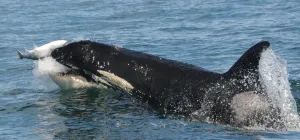(Press-News.org) Inspired by the eyes of mantis shrimp, researchers have developed a new kind of optical sensor that is small enough to fit on a smartphone but is capable of hyperspectral and polarimetric imaging.
"Lots of artificial intelligence (AI) programs can make use of data-rich hyperspectral and polarimetric images, but the equipment necessary for capturing those images is currently somewhat bulky," says Michael Kudenov, co-corresponding author of a paper on the work and an associate professor of electrical and computer engineering at North Carolina State University. "Our work here makes smaller, more user friendly devices possible. And that would allow us to better bring those AI capabilities to bear in fields from astronomy to biomedicine."
In the context of this research, hyperspectral imaging refers to technologies that can break down the visible wavelengths of light into more narrow bands. The human eye can't distinguish between these slight variations in color, but computers can - making hyperspectral imaging valuable for tasks such as determining the chemical composition of objects in the image.
Polarimetry refers to the measurement of polarization in light, which is data that can be used to determine the surface geometry of an object in the image. For example, is the surface rough or smooth? And what is the angle of the surface relative to the light source?
Light is famously tricky to describe, since it is both a particle and a wave. If a wave of light is moving from Point A to Point B, the path between those two points is the direction of the light. If you think of the light as a particle, it is moving in a straight line from Point A to Point B. But the light is also an electromagnetic field that fluctuates like a wave. If you picture that wave as wiggling up and down or side to side as it travels from Point A to Point B, polarization is a measurement of the orientation of that wave along the path.
While there are larger devices that are capable of capturing hyperspectral and polarimetric images, smartphone-sized imaging technologies have run into significant challenges.
For example, the design of cell phone camera technologies results in very slight errors in the alignment of the different wavelengths of light in the final image. The result is not a big deal for taking family photos, but is problematic for scientific image analysis. And the problem is exacerbated when a camera can capture more colors, as is the case with hyperspectral technologies.
The creators of the new light sensors were inspired by the eyes of mantis shrimp, which are exceptionally good at accurately capturing subtle gradations of color. So, the researchers created an organic electronic sensor that mimics the mantis shrimp's eye. It's called the Stomatopod Inspired Multispectral and POLarization sensitive (SIMPOL) sensor. And, yes, stomatopod is the fancy name for mantis shrimp.
The researchers developed a prototype SIMPOL sensor that can simultaneously register four spectral channels and three polarization channels. By comparison, the charge-coupled devices used in smartphones have only three spectral imaging sensors, which detect red, green, and blue; and only two polarization channels. In addition, the SIMPOL prototype can measure the four color channels and three polarization channels at one point, whereas CCDs rely on imaging sensors spread across several points.
While only a proof of concept, the researchers used modeling simulations to determine that the design could be used to create detectors capable of sensing up to 15 spatially registered spectral channels.
"SIMPOL's color channels can discern spectral features 10 times narrower than typical imaging sensors; in other words, it is 10 times more precise," Kudenov says.
"Our work demonstrates that it is possible to create small, efficient sensors that can simultaneously capture hyperspectral and polarimetric images," says Brendan O'Connor, co-corresponding author of the paper and an associate professor of mechanical and aerospace engineering at NC State. "I think this opens the door to a new breed of organic electronic sensing technologies."
INFORMATION:
The paper, "Mantis shrimp-inspired organic photodetector for simultaneous hyperspectral and polarimetric imaging," appears in the journal Science Advances. First author of the paper is Ali Altaqui, a postdoctoral researcher at NC State. Co-corresponding author of the paper is Brendan O'Connor, an associate professor of mechanical and aerospace engineering at NC State. The paper was co-authored by Pratik Sen, a former Ph.D. student at NC State; Harry Schrickx, a Ph.D. student at NC State; Michael Escuti, a professor of electrical and computer engineering at NC State; the late Robert Kolbas, a former professor of electrical and computer engineering at NC State; Jeromy Rech and Wei You of the University of North Carolina at Chapel Hill; and Jin-Woo Lee and Bumjoon J. Kim of the Korea Advanced Institute of Science and Technology.
The work was done with support from the National Science Foundation under grants 1809753 and 1639429; and from the National Research Foundation of Korea, under grant NRF-2017M3A7B8065584.
Researchers have analyzed tracking data for 5,775 birds across 39 species of albatrosses and large petrels -- threatened seabirds whose ranges span many countries and the high seas -- to estimate how responsibility for their protection should be distributed among nations and international organizations. The authors note that albatrosses and large petrels from all breeding countries spend much of their time on the high seas, indicating that effectively managing these waters is of global interest. These estimates are critical to inform ongoing United Nations discussions to design a global treaty for conserving biodiversity in the high seas, beyond national jurisdictions, the authors write. Many species of albatrosses and ...
CHAPEL HILL, N.C. - First-year college students are reporting symptoms of depression and anxiety significantly more often than they were before the coronavirus pandemic, according to a study by the University of North Carolina at Chapel Hill.
The study, embargoed for release until March 3, 2021, at 2 p.m. EST, in the journal PLOS ONE, is based on surveys of 419 Carolina students, and reflects the challenge of colleges nationwide to support student well-being.
The study is unique among the growing reports of COVID-19's toll on mental health: researchers followed the ...
The source of potentially hazardous solar particles, released from the Sun at high speed during storms in its outer atmosphere, has been located for the first time by researchers at UCL and George Mason University, Virginia, USA.
These particles are highly charged and, if they reach Earth's atmosphere, can potentially disrupt satellites and electronic infrastructure, as well as pose a radiation risk to astronauts and people in airplanes. In 1859, during what's known as the Carrington Event, a large solar storm caused telegraphic systems across Europe and America to fail. With the modern world ...
A huge volume of digital data has been harvested, stored and shared in the last few years - from sources such as social media, geolocation systems and aerial images from drones and satellites - giving researchers many new ways to study information and decrypt our world. In Switzerland, the Federal Statistical Office (FSO) has taken an interest in the big data revolution and the possibilities it offers to generate predictive statistics for the benefit of society.
Conventional methods such as censuses and surveys remain the benchmark for generating socio-economic indicators at the municipal, cantonal and national levels. But these methods can now be supplemented with secondary, mostly pre-existing data, from sources such as cell-phone ...
More than five years after receiving an experimental immunotherapy drug, half of a group of people at high risk of developing Type 1 diabetes remained disease-free compared with 22% of those who received a placebo, according to a new trial overseen by Yale School of Medicine researchers.
And those who developed diabetes did so on average about five years after receiving the new drug, called teplizumab, compared with 27 months for those who received the placebo.
The study, which was done in collaboration with researchers from Indiana University, was published March 3 in the journal Science Translational Medicine.
"If approved for use, this will be the first drug to delay or prevent Type 1 diabetes," ...
A series of nanoparticle-based vaccines elicits protective antibodies against various strains of the influenza virus in nonhuman primates, according to work from Nicole Darricarrère and colleagues. Although more research is needed, the vaccines mark an important step toward a universal flu vaccine for humans, which has long been a major goal for infectious disease researchers. Current seasonal flu vaccines can prevent disease but often only work for a year, after which a new vaccine must be developed. This occurs because influenza viruses evolve extremely quickly, meaning that a year-old vaccine may not prepare the immune system to recognize a new ...
Endangered Southern Resident killer whales prey on a diversity of Chinook and other salmon. The stocks come from an enormous geographic range as far north as Alaska and as far south as California's Central Valley, a new analysis shows.
The diverse salmon stocks each have their own migration patterns and timing. They combine to provide the whales with a "portfolio" of prey that supports them across the entire year. The catch is that many of the salmon stocks are at risk themselves.
"If returns to the Fraser River are in trouble, and Columbia River returns are strong, then prey availability to the whales potentially balances out ...
Scientists from the Skoltech Center for Design, Manufacturing and Materials (CDMM) and the Institute for Metals Superplasticity Problems (IMSP RAS) have studied the fatigue behavior of additive-manufactured high-entropy alloys (HEA). The research was published in the Journal of Alloys and Compounds.
Conventional 20th century materials that are extensively used in industries and mechanical engineering have reached their performance limit. Nowadays, alloying is commonly used to improve the alloys' mechanical performance and increase their operating temperature. ...
Coastal communities at the forefront of climate change reveal valuable approaches to foster adaptability and resilience, according to a worldwide analysis of small-scale fisheries by Stanford University researchers.
Globally important for both livelihood and nourishment, small-scale fisheries employ about 90 percent of the world's fishers and provide half the fish for human consumption. Large-scale shocks -- like natural disasters, weather fluctuations, oil spills and market collapse -- can spell disaster, depending on the fisheries' ability to adapt to change. In an assessment of 22 small-scale fisheries that experienced stressors, researchers revealed that diversity and flexibility are among the most important adaptive capacity factors ...
Humans were present in Florida by 14,000 years ago, and until recently, it was believed the Bahamas - located only a few miles away - were not colonized until about 1,000 years ago. But new findings from a team including a Texas A&M University at Galveston researcher prove that the area was colonized earlier, and the new settlers dramatically changed the landscape.
Peter van Hengstum, associate professor in the Department of Marine and Coastal Environment Science at Texas A&M-Galveston, and colleagues have had their findings published in PNAS (Proceedings of the National Academy of Sciences).
Researchers generated a new ...


